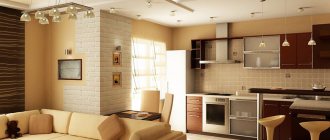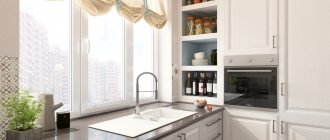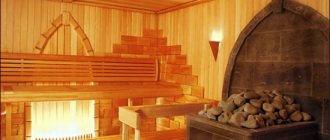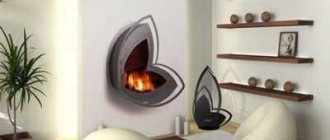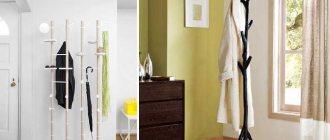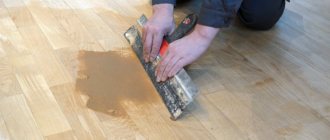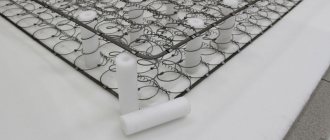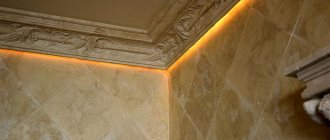Drywall is good because it allows you to quickly and efficiently level walls or ceilings. But the material has one significant drawback: it is fragile and is not designed for the load of a wall cabinet or shelf. Traditional fastening methods in the case of gypsum plasterboard surfaces are unreliable: the material begins to crumble. In such a situation, a fundamentally different fastener is used - a special dowel for drywall.
Kinds
There are several types of dowels that allow you to attach suspended structures to gypsum boards:
- Butterfly.
- Driva plastic or metal screwdriver.
- Molly.
- Fischer dowel.
- KNAUF Hartmut.
- An ordinary dowel-nail.
- Spring-loaded.
Each of these types of fasteners has advantages and disadvantages. To figure out which one is more profitable to use in a specific situation, let’s take a closer look at them.
Butterfly dowel
This fastening element received its name because, when tightened, its shape resembles a butterfly. When a screw is screwed into it, the wings of the dowel open and rest against the surface of the drywall on the reverse side. To prevent the element from scrolling, special cuffs are provided.
By design, the “butterfly” can be considered as a lightweight and cheaper version of the Molly dowel.
This type of fastener is intended for small lamps, cornices or baseboards, fixing electrical wiring, switches. According to the manufacturers, it can withstand loads of up to 28 kg.
The instructions for installing the butterfly dowel are simple:
- In the right place, using a drill of the appropriate diameter, a hole is made for the dowel.
- The side “wings” are compressed by hand, after which the fastening element is inserted into the hole. It should fit tightly, so it is recommended to use a hammer for upsetting. In this case, the notches on the dowel body should penetrate the drywall from the front side. This will prevent the element from scrolling.
- When screwing in the self-tapping screw, you need to ensure that the wings are tightly pressed to the surface of the sheet on the back side of the drywall.
The nuances of butterfly installation are shown in the video.
USEFUL INFORMATION: Calculate the amount of drywall and ceiling profiles: online calculator
Advantages of this type of fastening:
- ease of installation;
- Possibility of removal if necessary.
There are also disadvantages:
- To use, you need free space behind the surface of the gypsum board.
- The use of these dowels is limited by the thickness of the plasterboard coating - up to 12 mm. That is, when installing gypsum boards in two or more layers, such fasteners will not work.
Application of the tap
Before you start threading, you need to determine the diameter of the preparation hole and drill it. To facilitate this task, a corresponding GOST was developed, which contains tables that allow you to accurately determine the diameter of the threaded hole. This information makes it easy to select the drill size.
To cut metric threads on the inner walls of a hole made with a drill, a tap is used - a screw-shaped tool with cutting grooves, made in the form of a rod, which can have a cylindrical or conical shape. On its side surface there are special grooves located along its axis and dividing the working part into separate segments, which are called combs. The sharp edges of the combs are precisely the working surfaces of the tap.
Tap: design and parameters
In order for the turns of the internal thread to be clean and neat, and for its geometric parameters to correspond to the required values, it must be cut gradually, by gradually removing thin layers of metal from the surface being treated. That is why for this purpose they use either taps, the working part of which is divided along the length into sections with different geometric parameters, or sets of such tools. Single taps, the working part of which has the same geometric parameters along its entire length, are needed in cases where it is necessary to restore the parameters of an existing thread.
The minimum set with which you can sufficiently perform machining of threaded holes is a set consisting of two taps - rough and finishing. The first one cuts a thin layer of metal from the walls of the hole for cutting metric threads and forms a shallow groove on them, the second one not only deepens the formed groove, but also cleans it.
Types of thread taps and their differences
Minimum set of taps
Combination two-pass taps or sets consisting of two tools are used for tapping small diameter holes (up to 3 mm). To machine holes for larger metric threads, you must use a combination three-pass tool or a set of three taps.
To manipulate the tap, a special device is used - a wrench. The main parameter of such devices, which can have different designs, is the size of the mounting hole, which must exactly match the size of the tool shank.
Some types of tap drivers
When using a set of three taps that differ both in their design and geometric parameters, the sequence of their use must be strictly observed. They can be distinguished from each other both by special marks applied to the shanks and by design features.
- The tap, with which the hole for cutting metric threads is processed first, has the smallest diameter among all the tools in the set and cutting teeth, the upper part of which is heavily cut off.
- The second tap has a shorter fence and longer combs. Its working diameter is intermediate between the diameters of the other tools in the set.
- The third tap, with which the hole for cutting metric threads is processed last, is characterized by full ridges of cutting teeth and a diameter that must exactly match the size of the thread being formed.
Set of three taps
Taps are used primarily for cutting metric threads. Much less often than metric ones, taps designed for processing the internal walls of pipes are used. In accordance with their purpose, they are called pipe, and they can be distinguished by the letter G present in their markings.
Dowel Driva
This is a metal, plastic or nylon hollow rod with a screw thread. The head has slots for a Phillips screwdriver.
It is more convenient to use the Driva type of dowel equipped with a drill. Then the installation is greatly simplified:
- Using a screwdriver, the element is screwed into the wall.
- A screw is screwed into the cross-shaped slot of the dowel, which pushes it apart from the inside. This ensures that the element is firmly fixed in the drywall.
For the Driva variety, which does not have a drill at the end, a hole with a diameter of 6 mm is prepared in advance.
The length of the plastic dowel is 23 mm, but the size of the metal ones varies from 33 to 44 mm. Therefore, when choosing fasteners, the thickness of the wall is taken into account.
The main advantages of the Driva mount:
- Low price of hardware.
- It is not necessary to have free space behind the ceiling.
- If necessary, simply dismantle.
- Plastic models are designed for loads up to 25 kg, metal ones – up to 35 kg.
Attaching to an unstable surface
Modern houses have many surfaces made of not very durable materials. These include drywall, old brick, wooden boards or slabs of pressed sawdust. When working with them, it is better to use nylon fasteners with a diameter of more than 10 mm; the installation depth should not be less than 6 cm. It is better to choose a gimlet that is several sizes smaller.
Read also: How to change the coil on a doffler trimmer
The drilling process should be shock-free, as excessive load can damage the surface. Using the impact mode may not leave visible damage, but the internal structure of the wall may be damaged. If the diameter of the drill is too large, the fasteners will move freely in the hole, gradually increasing its diameter, especially if the work was carried out with aerated concrete.
For plasterboard walls, it is not necessary to use a drill of a smaller diameter, the main thing is not to put pressure on the drill and not to use the impact mode. Drywall is a very delicate material, even a small load can lead to the destruction of a section of the wall. Drill the hole with light force so that it matches the size of the plastic dowel with self-tapping screw.
It is worth understanding that there is no need to attach heavy structures to such surfaces, even if the material initially copes with the load, over time, collapse may occur under heavy weight.
If you take into account the material from which the wall is made, choose the right dowel and drill for it, and also have a high-quality tool on hand, you can make a high-quality installation and not worry about the safety of your furniture or household appliances. By following the recommendations, even an inexperienced craftsman can handle such installation.
If you find an error, please select a piece of text and press Ctrl+Enter.
What are the basic principles for choosing a drill for a dowel? How should the diameter of the dowel and drill correspond?
There are several options for selecting a drill for a dowel. This point of choice should depend on the type of work expected and the quality of the working surface.
if the wall is reinforced concrete or brick, of solid masonry and you intend to hang a light object, then it is best to choose an impact dowel with a diameter of 6 mm and a Pobedit drill of the same diameter. In this case, the dowel must extend into the wall by at least 40 mm, and into the ceiling by 60 mm. The minimum number of dowels is 2 pcs.
If you are going to attach medium-weight objects (5–10 kilograms) to a reinforced concrete or brick wall, it is recommended to use an impact dowel (8 mm in diameter) and an 8 mm Pobedit drill. In this case: the dowel should extend 60 mm into the wall, and 80 mm into the ceiling. The number of dowels used should not be less than 4 pieces.
If you plan to attach a heavy/large (static) object to a reinforced concrete or brick wall, you should choose an impact dowel and a 10 mm diameter Pobedit drill bit. In this case, the dowel should extend 60 mm into the wall, and 80 mm into the ceiling. The minimum number of dowels is 6 pcs.
When fastening heavy objects, including those with a large dynamic load (for example, steps of a ladder, horizontal bar, etc.), it is advisable to use anchor bolts with a diameter of 8 mm and a Pobedit drill of the same diameter. The bolt should go 60 mm into the wall, and 80 mm into the ceiling. The number of bolts for this type of work should not be less than 4 pieces.
In old houses and buildings, when choosing a dowel-drill pair, it is recommended to adhere to the following rule:
1) for fastening you need to use nylon dowels with a diameter of 10 or 12 mm. It should fit into the wall approximately 60 mm.
2) you need to drill a hole with a Pobedit drill, the diameter of which will be 2 mm less than the diameter of the dowel used. This is done because the drill strongly “breaks” the hole in the soft material of the walls of old houses/buildings.
Dowel Molly
It resembles an umbrella in its principle of operation. Withstands significant loads - up to 35 kg.
The installation process is as follows:
- A hole is drilled in the wall or ceiling to match the diameter of the dowel (usually 8 mm).
- The sleeve is inserted into the hole so that the teeth located on the cap cut into the surface. This will prevent the fasteners from turning.
- Screw in the screw until the opening triangles dig into the drywall on the back side of the sheet, ensuring a secure fixation.
The advantages of Molly dowels are obvious: due to the formation of a cone-shaped structure on the back of the gypsum board, they increase the support area and prevent the sheet from breaking under load. Disadvantages include high cost and the need for free space behind the plasterboard.
Note! Molly cannot be dismantled: you will have to break the wall to remove it.
And here is a video instruction for installing Molly:
USEFUL INFORMATION: Tape for sealing drywall joints: perforated paper and serpyanka
Crown for installing mounting boxes
The most common need to drill round holes in drywall is to install electrical outlets. The invisible part of the socket, the plastic round mounting box that is mounted in the wall, is called the socket box. There are socket boxes for concrete, wood and plasterboard.
The socket box for drywall is a plastic cup with adjustable plates made of plastic or metal. Thanks to these “claws,” the socket box is fixed to the back of the plasterboard sheet. The depth of the installation box can be 40, 50, 60 or 73 mm. As for the diameter, for a standard socket box it is usually 68-70 mm.
If you only need to drill holes to mount sockets, you will only need one hole saw. In this case, you should not purchase a set of dismountable crowns. It is enough to buy one special core drill, with a diameter of 68 or 70 mm (depending on the size of your socket boxes).
Today, the diameter of a core drill for drywall 68 mm is the most popular standard size.
Fischer P.D.
One of the newest and most convenient developments in the field of drywall fasteners. The principle of operation is original in that when the self-tapping screw is screwed into the dowel, its conical shank is pressed into the plastic sleeve, forcing the stop wings to open. When the sheet thickness is small, they apply pressure from the back side. If the thickness of the drywall is significant, they will jam the dowel in the drilled hole.
Such fasteners can withstand 12–15 kg. Installing it is simple:
- Preparing a hole in the drywall.
- The dowel is inserted. Longitudinal ribs will prevent it from turning, and a reinforced flange will prevent it from falling into the hole.
- The locking screw is tightened. As it moves, the “wings” open and the dowel is fixed.
"Har
Champion among fasteners in terms of weight held. Capable of withstanding loads up to 55 kg. It consists of a metal U-shaped bar with locking bushings and two plastic guides.
Installation diagram:
- A hole with a diameter of 13 mm is drilled in the drywall.
- A metal strip is inserted into it. By pulling the guides and aligning them relative to each other, it must be brought into working position.
- The guides are inserted into a clear plastic sleeve. It is inserted into the hole until it stops.
- The ends of the guides move in different directions and then break off.
- The screw included in the delivery set is screwed into the dowel.
Installation of Hartmut fasteners: step 1
Step 2
Step 3
Step 4
Step 5
Step 6
Rear view
The result is a very reliable fulcrum that can withstand heavy loads.
Dowel-nails
Also used when hanging light objects on plasterboard surfaces. This fastener is popular because of its convenience and low price. It is usually made of plastic, but there are also aluminum varieties.
Installation is simple:
- A hole is drilled corresponding to the thickness of the hardware.
- The plastic part is carefully driven in with a hammer.
- The screw rod is also driven in with a hammer. It has Phillips slots in case you need to remove the screw. But it is almost impossible to get the plastic part out of the gypsum board.
USEFUL INFORMATION: Modular sockets on DIN rail
For all their convenience, these hardware are used for fastening only light objects to a plasterboard surface.
Spring anchor
This fastener element is also called a dowel, although this is not entirely true. It is often used for attaching suspended structures, such as lamps, to the ceiling. It is a screw equipped with two stops that are released by a spring.
They attach it like this:
- A hole of the required diameter is drilled in the ceiling.
- An anchor is inserted into it, having previously folded the blades and holding them from opening. Once behind the plasterboard surface, they will automatically open, ensuring reliable fastening.
Please note that it is impossible to dismantle the spring suspension.
A competent choice of fastening elements will not only ensure reliable fixation of suspended structures on the surface of the drywall, but will also protect the plasterboard from unnecessary damage.
Main types of fastening devices suitable for drywall
Dowel Driva
As a rule, it is used for fastening not too heavy objects. Available in both plastic and metal versions. Unlike its analogues, it does not have a spacer principle, which gives it the ability to interact with any screw, although universal self-tapping screws would be an ideal option. You just need to remember that the length of the plastic version is 23 millimeters, and the metal version is up to 44 millimeters.
It also differs in that it does not require pre-drilling, although most craftsmen still make holes in advance. The peculiarity of this dowel is that it also does not require free space between the sheets, and it can also be effectively used for double plasterboard.
Dowel Molly
One of the expensive fastener options, but the high price is compensated by high efficiency. Available in plastic and metal versions. At the same time, metal is more popular. The principle of operation of the element is to open its flaps in the space behind the drywall (the latter is necessary) and press it against the back side of the gypsum board.
Among the advantages of the fastening element are the following:
- Easy installation and quick dismantling;
- There are teeth on the side, which allows you to achieve reliable fixation of the anchor in the wall without twisting;
- The fastening material can withstand very serious loads.
Dowel Fischer pd
It is the same butterfly as many of its “classmates”. In the case of the Fischer pd, a plastic fastening element is inserted into the hole made, after which the screw tightens the two parts of the fastening element, forcing one to fit under the other and open in the form of petals.
The fastener itself can be used for mounting cabinets and wall lighting fixtures. However, you need to understand that while the fastening is reliable, this dowel has a short expansion zone, which in turn requires a little screwing or a small space inside the gypsum board.
Dowel-umbrella
Ideal for attaching various loads to plasterboard ceilings. Such a screw, opening already behind the gypsum board, straightens its “shoulders”, which makes it possible to distribute the load over a much larger area, which allows you to hang even heavy chandeliers from a plasterboard ceiling. However, there is a limit to everything, and if your lighting device is really extremely heavy, then it is still better to use fasteners directly to the concrete floor.
Self-tapping dowel
It usually consists of a plastic tip and a metal screw. The most common option that is familiar to all of us. At the same time, it has different sizes, allowing you to work with a wide variety of gypsum board thicknesses. But you need to understand that you should not choose an option that is too long so that it does not stick out on the other side.
As a rule, it is not necessary to drill a hole for this dowel, however, in the case of a plasterboard sheet with a thickness of more than one and a half centimeters, preliminary drilling becomes necessary.
